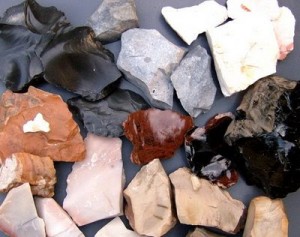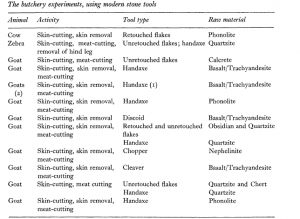Experimental archaeology is a field of study that attempts to generate and test archaeological hypotheses, usually by replicating or approximating the feasibility of ancient cultures performing various tasks or feats. When focusing on tool making, archaeologists will often recreate these tools to the best of their ability in the hope of learning the answers to questions such as why or how these tools were used. The imitation of flint knapping can lead archaeologists to answers about the difference in tool making and usage of tools from different time periods and/or locations.
This past summer Professor Lucy Johnson and three Vassar students produced a comparative analysis of tool making debris from Native American sites in New York to a site located on Unga Island in Alaska. Specifically, their research was angled toward the determination of whether or not different cultures produce different tool-making debris or if the debris is constant despite the location of the tool making. It was determined that in the New York State sites, the Native American knappers were approaching how they were going to knap in similar matters based on the consistent finds among all sites. Additionally, the weight distribution, striking platform, and limited dorsal cortex of the debris were coherent between both the New York and Alaska site. Based on this evidence, it can be determined that sites that reflect similar stages in the knapping process show similar trends in flake attributes. The distinguishing factor between these two sites would be the use of brittle volcanic stones in Alaska and chert in New York State. While the process remains the same despite the material utilized, the volcanic stones are harder to control and probably led to a more time-consuming knapping process.
Peter Jones and his experimental butchery with modern stone tools exhibits another usage of experimental archaeology. Within his study, Jones looks at the efficiency of various stone tools such as large hand axes, cleavers, retouched flakes, etc. His overall objective was to determine which of these tools worked better in the cleaving and skinning of numerous animals of different sizes (goats, zebras, etc.) and to rationalize what this may have meant for hunters and knappers in the early Paleolithic and Pleistocene. His overall conclusion inferred that large, generally bifacially flaked tools are more efficient than small plain flakes for most butchery tasks. Large tools would be advantageous due to their weight and long cutting edges. However, at predominant Paleolithic Sites there has been an abundance of small flakes and flake tools discovered. In Jones’ opinion, these are the result of tool re-sharpening and/or reworking.
In my opinion, experimental archaeology is one of the few methods that can effectively aid in the understanding of previous stone tool assemblage and usage…most of the time. I remain cautious due to the fact that although our methods may be succinct, we can never be sure because we didn’t coexist with these people. History and archaeology are not about finding the “right answer.” They exist to build a logical story of events that may or may not be true due to what we know.
References:
Jones, P. (n.d.). Experimental butchery with modern stone tools and its relevance for Palaeolithic archaeology. World Archaeology, 153-165. Retrieved October 4, 2
Nehawka Primitive Skills. (n.d.). Retrieved October 4, 2014, from http://nehawkaprimitiveskills.blogspot.com/2008/09/flintknapping-101-material.html
Ancient Craft – Experimental Archaeology. (n.d.). Retrieved October 4, 2014, from http://www.ancientcraft.co.uk/experi_arch/experimental_archaeology.html
Future Reading:
Newcomer, M., & Sieveking, G. (1980). Experimental Flake Scatter-Patterns: A New Interpretative Technique. Journal of Field Archaeology, 345-352. Retrieved October 4, 2014.
Marzke, M., & Shackley, M. (n.d.). Hominid Hand Use In The Pliocene And Pleistocene: Evidence From Experimental Archaeology And Comparative Morphology. Journal of Human Evolution, 439-460. Retrieved October 4, 2014.


